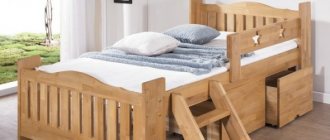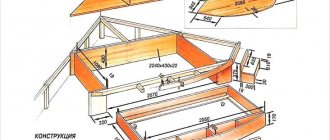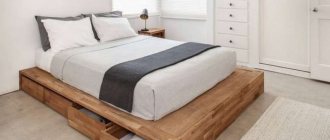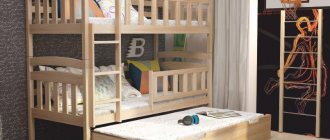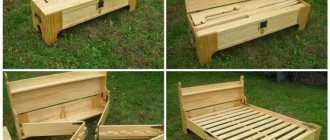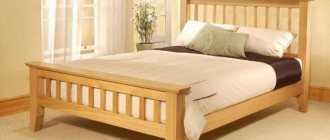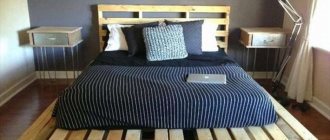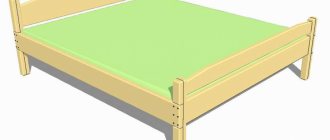01.10.2019
7421 Views,
When choosing pieces of furniture, one of the main priorities remains their functionality. A bed with a lifting mechanism in the bedroom is not only a sleeping place, but also an effective component of furniture.
Beds with a lifting mechanism got their name due to the presence of a special elevator, which allows you to lift the mattress above the bed frame with just one movement. The box under the bed is often called a linen closet because it is where bed linens, pillows, and blankets are usually stored. In essence, such a bed is a mechanized system designed both for relaxation and for storing things.
Principle of operation
All modern beds with a lifting function work on a similar principle - moving the base, lifting it to a certain angle and maintaining the position using both muscle force and special clamps.
The design of most mechanisms is approximately the same: there are two metal plates, upper and lower, which are attached to the base and side of the laundry box, respectively. The connection of these plates is carried out using a special rod (or rods - there may be several of them), the location of which forms an opening arc.
The operating principle of all beds is approximately the same.
Important! In most cases, such a mechanism is equipped with a force compensator to make the base easier to lift, but in the cheapest options it is usually absent.
Types and varieties
Today, many multifunctional beds can have a built-in mechanism made according to one of three common design schemes:
Manual lift hinges
This design involves lifting solely through muscular strength. Considering that there will be a mattress, a blanket and, often, pillows on the base, then significant effort will be required. This solution assumes the presence of only a ratchet, which allows you to fix the opening angle - no springs or shock absorbers are provided here.
A bed with a manual mechanism will require considerable effort to lift.
Mechanism with spring compensator
This option is structurally similar to a manual mechanism. The key difference here is the presence of a compensating spring, which is in working condition (stretched) when the substrate is lowered. During the lifting process, the spring begins to compress, which partly reduces the degree of force applied.
In a spring mechanism, part of the load is carried by the spring.
Gas lift
This is what professional jargon calls a gas shock absorber, which is installed to relieve some of the effort when lifting the base, and also as an extreme position lock. Unlike the previous case, this solution allows you to easily and smoothly transform the bed.
With the help of a gas lift, the bed rises easily and smoothly.
Lift-up bed in the interior: advantages and features
A transforming bed that retracts under the ceiling allows you to implement the most daring solutions of designers and architects. Original sleeping furniture is an ideal solution for small apartments and studio apartments. A lifting bed to the ceiling does not overload the space and gives the interior lightness and airiness. In the evening and at night, the lift bed serves as a standard sleeping place; during the day, the bed raised to the ceiling frees up the space of the room, allowing you to use the room as a living room, dining room, study or play area for your children. The lower part of the bed can be equipped with built-in lamps, which, when the furniture is raised, will serve as additional or decorative lighting.
Structurally, the bed rising to the ceiling is a platform that moves up and down vertically like an elevator through a special mechanism. When in the lower position, the lift-bed is fixed for reliability using retractable legs.
A bed descending from the ceiling has the following advantages:
- saves room space - to functionally organize the space between the vertical bed posts, open shelves or cabinets can be installed. Under the lift-bed you can place a small sofa, ottoman, coffee table and other low pieces of furniture;
- saves time - the sleeping bed is constantly in a horizontal position, so there is no need to clean and spread the bed linen every day;
- does not require effort to lower and lift;
- brings originality to the design of your home.
Beds with a lifting mechanism: advantages and disadvantages
Most of the advantages of lift-top beds can be attributed to any type of opening mechanism. Therefore, it makes sense to highlight the positive aspects common to all designs:
- Compactness. Bed linens, blankets, pillows and clothes are stored under the bed, freeing up space elsewhere.
- Low noise level.
- Easy to use.
- Reliability. Especially in solutions where gas lift is used.
- Wide range of bed frames. You can choose a bed with a lifting mechanism to suit every taste and budget.
- Easy to maintain.
Lift beds have many advantages.
There are also disadvantages, which are typical for all options:
- Small gap between the bottom and the floor surface. When dust accumulates under the bed, removing it from there is a rather labor-intensive task without rearranging it.
- Lack of mobility. Due to its dimensions, such furniture can be placed in one place for a long time.
- Sagging. Cheap foundations begin to weaken over time, which affects the use of the structure as a whole.
The design also has its drawbacks.
Moreover, each version of the lifting mechanism has its own pros and cons.
Manual
The advantages include simplicity of design, reliability and ease of maintenance. As for the disadvantages, there is only one, but a significant one - the applied force required to lift the base.
The manual mechanism is the simplest and most reliable.
Spring
The advantage of this solution is the presence of a compensating effect, which allows you to remove part of the load (muscle force) during operation of the mechanism. The negative side will be the need to periodically replace the springs (over time they lose their original stiffness and stretch), as well as the complexity of installation, adjustment of the compression force and increased noise levels.
The springs will need to be changed periodically.
Gas bed lift mechanism
The advantage of gas shock absorbers is smooth operation during operation, lack of noise, unpretentiousness and durability. Among the disadvantages, it is worth mentioning the short stroke, reduced efficiency at low temperatures, and the impossibility of repairing at home.
Gas lift has both pros and cons.
Design options
The first step is to decide on a suitable design option.
The design and shape of the bed, as well as the organization of the suspension system, are closely interconnected. And now you will find out why.
Hangers for wall-mounted beds are divided into several categories.
[adv1]
- Suspension installed to the ceiling. It is not very difficult to secure such a structure. But here a prerequisite is the presence of durable fasteners. Please note that not all floors are suitable for such tasks;
- Wall mounting. Initially it seems simple. But in fact the task is not easy. Even more powerful fastenings are required, since a slightly different load distribution vector is provided here;
- Combined method. This is a wall and ceiling fixation. In terms of implementation, one of the simplest. Helps in situations where it is necessary to reduce the impact load on the floor;
- Installing the bed on one side to the wall and attaching hanging elements to it. This option is the simplest and is used most often than others.
Now think about what is suitable specifically in your case.
You should choose a mount based on the shape of the bed, since a certain type of connection is suitable for each of them.
If you follow the classical scheme, you can distinguish 3 types of beds based on their shape.
All of them can be suspended. Just keep in mind that the installation instructions will differ.
As you know, beds for good sleep, and not hammocks, are:
See also
Aristo coupe doors: what are the advantages, how to calculate and assemble
- Round. Hanging options are very limited. Ceiling mounted only. The design itself requires a lot of space to accommodate. When swinging, it may hit walls;
- Square. Potentially all installation options are suitable for square beds. But such beds are only suitable for spacious rooms;
- Rectangular. The most common. Mounted using all the methods presented. The easiest to assemble yourself.
If desired, the bed design can be supplemented with various decorative elements, fences, protective sides and more.
How to choose a good mechanism?
When planning to purchase a bed with a lift-up top, in addition to other selection criteria, you should also pay attention to the installed lifting mechanism. It is recommended to consider the following:
- Compression force. Determines the force required to raise or lower the base, along with the mattress and bedding.
- Number of compensators. Typically, mechanisms using springs or gas shock absorbers are installed on both sides of the box. This allows you to reduce the applied force at the moment of opening and reduce the requirements for spring or gas lift power.
- Opening angle. Most often, this parameter directly depends on the capabilities of the compensating element.
- Workmanship. The ease of use and longevity of the mechanism directly depend on the reliability of the fastenings. Therefore, it is advisable to reject options using cheap designs. It is better to give preference to German or Italian manufacturers.
The choice of mechanism is carried out according to certain criteria.
Important! Typically, the power of the compensator is indicated in Newtons (N), while for springs it is determined by its stiffness, and for gas lift - by the pressure in the cylinder. For a single bed, this value starts at 300N, however, depending on the design, it can reach 2kN.
The power of the compensator may differ for different models.
DIY mechanism: what is needed for this?
The simplicity of the basic design suggests that such a mechanism can be made by yourself. This is partly true, but only if you have experience working with metal, a drilling machine and a welding machine.
You can also make a structure with a lifting mechanism yourself.
If we talk about manufacturing in the context of general operating principles, we can highlight several key points:
- Drawing. Design features such as the width of the support plate flange, the length of the rods and the distance between the holes are calculated depending on the point of application of the load, its nature (point or distributed), as well as the position of the axis relative to the center of mass of the entire structure. If such calculations are difficult to do on your own, it is recommended to look for the most suitable ready-made solution.
- Construction type. The manual version is the simplest from a production point of view. However, if you want to install a compensator, the choice here is obvious - a gas shock absorber. Installing a spring requires an accurate calculation of its stiffness: a weak one will not hold the base, but a too stiff one will require significant effort when opening. In addition, it may simply not be in the store.
- Nature of use (intensity). This will determine how powerful (reliable) the mechanism is needed.
Installation of the lifting mechanism
When planning to assemble the Suspa device, you should familiarize yourself with the basic recommendations of the manufacturer of this hardware. The gas lift installation process can be divided into several successive steps:
First, the bed frame is assembled. When performing all operations, follow the manufacturer's instructions. Metal corners are used to connect the boards. This will strengthen the entire structure and make it more resistant to external influences.
When the frame is assembled, they begin to attach the gas lift. The structure is fixed using special self-tapping screws, which are often included. Please note that some gas lifts are one-sided
Therefore, it is important not to confuse them.
In some cases, the side of the cylinder also plays an important role. This specification should be clarified with the manufacturer.
At this stage, the folding frame is assembled. In some cases it is metallic and solid. If the structure is made of wood, then it is constructed in accordance with the manufacturer’s instructions. The procedure is completed by attaching the gas lift to the upper element
It is important to screw the mechanism only when the lid is open. This will eliminate the possibility of breakage due to incorrect calculation of the arm length
When the entire structure is assembled, you should run the system several times to check its functionality. If the system does not work properly, the mechanism should be reinstalled.
Installing gas lifts on a bed can differ in many nuances. If you are not sure that you can perform the operation efficiently, you should entrust it to an experienced specialist. The best option would be to make such furniture to order. This will allow you not only to select the size and style of the structure, but also to determine the optimal characteristics of the lifting mechanism.
If you still want to handle all the work yourself, consider important nuances. This way you can get better results. To learn how to install a gas lift, see the following video.
Installation specifics
Based on the similarity of the circuit diagram and design features of most lifting mechanisms, we can propose a certain universal approach regarding their installation:
- Preparing the frame. First of all, you need to assemble the bed frame. In this case, it is enough to prepare a box (linen box) and a base for the mattress. At this stage they will be separate elements.
- Assembly of the mechanism. If this is a purchased product, it may either already be assembled, or appropriate instructions should be included with it. For a homemade mechanism, you should adhere to the considerations on the basis of which the design was developed (assembly may include certain nuances that are specific only to a particular case).
- Actually, installation. First of all, the mechanism is attached to the sides of the linen drawer. For the standard version, this is done on both sides. At this stage, it is necessary to strictly maintain alignment at the landing points, otherwise, when opening, you can get not only vertical movement, but also rotation around the conditional center between the supporting side plates. The base is attached to the mating part of the structure.
- Functionality check. Here it is necessary to evaluate the performance of the mechanism as a whole: lifting the mattress backing, keeping it open, smooth operation, presence of runout or play.
Features of Lift Bed beds
The design of an elevator bed has no characteristic differences from a standard sleep bed and consists of a frame and a base for a mattress. The bed frame can be made of metal elements in combination with MDF or wooden beams.
The furniture market offers several standard sizes of beds that rise to the ceiling, standard frame sizes:
- 120x200 cm;
- 180x200 cm.
The base for the mattress can be:
- solid;
- lamellar;
- mesh.
The need for dismantling and its features
In most cases, disassembling the mechanism itself is not necessary. Even when transporting furniture, it usually remains folded on one of the parts of the frame. However, there are a number of circumstances that may require direct intervention in the structure:
- Spontaneous change in the position of the base.
- Jamming (jamming) of the mechanism, change in operating behavior other than typical.
- The appearance of squeaks, displacement in the horizontal plane, beating or friction in a certain place.
In some cases, the mechanism will have to be dismantled.
As a rule, such symptoms are signs of a malfunction of the lifting mechanism. To dismantle it, you should clear the bed of all unnecessary things, remove (unscrew) the base and, having gained access to the mechanism, inspect the condition.
Types of pull-out beds
Structurally, a roll-out bed is a piece of furniture consisting of two main parts: a base and a sleeping area, which can be pulled out if necessary.
Roll-out beds can be either regular or built-in. In the first case, a regular bed is used as a base, and an additional bed is pulled out when necessary. This is a good option for newlyweds and those who like to host guests in their home.
There are also children's double pull-out beds - this is an excellent alternative to bunk structures, safer and more comfortable.
But built-in beds are more popular. They can be built in:
- in a closet: this design allows you to significantly save space, but be prepared for the fact that such a closet is less functional than a full-fledged furniture wall, because its main part is occupied by a sleeping place;
- on the podium: this is a more practical option, the podium can serve as a working, sleeping or guest area, but it should be borne in mind that such a bed can visually “eat up” the room, therefore it is only suitable for rooms with high ceilings;
- in a decorative niche: a very stylish option for sophisticated interiors. Not suitable for saving space;
- on the windowsill: an option for true romantics and for those who like to enjoy the view from the window.
Pull-out beds can be of different sizes, both in length and width.
In width they are:
- single – from 80 to 100 cm;
- one-and-a-half - from 100 to 150 cm;
- double – from 160 to 220 cm.
Single beds are not really suitable for adults, but are a good option for teenagers.
Pay special attention to the length of the bed:
- for short people and teenagers - 190 cm;
- for people of short and average height - 195 cm;
- for tall people - 200 - 220 cm.
Don't forget to evaluate the height of the bed. The lower it is, the more difficult it is to get up from it. Therefore, roll-out structures that are too low are not recommended for older people. The ideal bed height is the level of your knees, but not all pull-out bed models meet this requirement.
Choosing a bed with a lifting mechanism
When choosing a bed equipped with a lifting mechanism, you need to pay attention to the following:
- Workmanship and design. No beating, jerking, creaking or play.
- Frame strength: the linen box matches the base used. A good frame should not allow deflection or sagging.
- The type of base itself. It is best to choose an option designed for an orthopedic mattress - it allows you to distribute the load more evenly.
- Materials and filling.
- Ease of use.
There are several factors to consider when choosing a bed.
The use of structures with a raised top can be an excellent help for residents of small apartments or adherents of minimalism. This can also be a good option for those who live alone - everything you need can fit in a linen drawer. Therefore, if there is such an opportunity, it makes sense to give preference to this particular solution.
